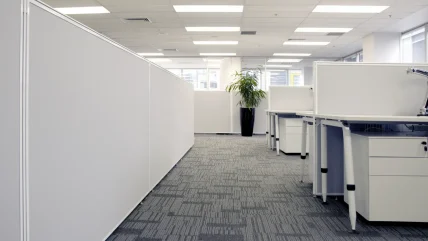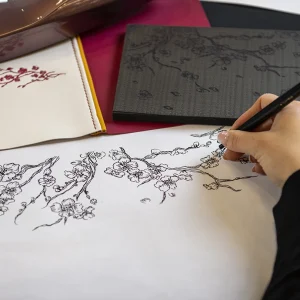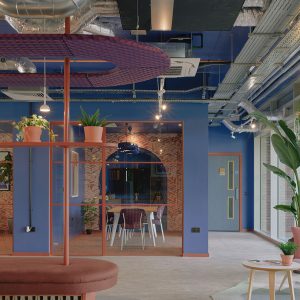
Adam Strudwick,
Head of interiors at Bisset Adams
What is the flooring you most commonly specify?
We use lots of carpet tiles for public-sector and education jobs. Carpet tiles are easy to maintain, quick to install and any damage can be replaced with a new tile easily. They are now available in more interesting patterns and colours so you can create some great visual impact. Also, the production has become much more sustainable for both the carpet and the backing.
What is the most unusual flooring you’ve specified?
Many of our recent projects are in existing builds, so we often refurbish the original floors where possible and where that works with the redesign of the rest of the building. This is not necessarily a cost issue, as refurbishing a wooden floor can cost as much as installing new flooring.
When you first visit a building you are not sure what flooring you are going to find and what condition it will be in; sometimes it’s not until you start lifting up old carpet that you know for sure.
It’s always exciting to uncover a hidden gem, such as an original terrazzo floor. They can have a beautiful, jewel-like quality when restored, and retaining them can add integrity to the overall design.
The users of the building are amazed that what they have been walking over was masking something so great to look at.
We are currently working on Blackpool Central Library, a Carnegie building from 1911. In this project we will refurbish the terrazzo floor, which is currently covered up. We will add an inlay of brass text into the existing design to really bring it to life.
Michael Sheridan,
Managing director of Sheridan&Co
What is the flooring you most commonly specify?
When creating permanent retail installations for upmarket beauty brands we often use ceramic tiles or high-performance polymetric flooring. These give a luxury feel with an uplifting lighting benefit and can handle high traffic. Make-up can be challenging for retail flooring, as what ends up on the floor can be difficult to remove unless you have a product which is easy to clean and resists stains.
What is the most unusual flooring you’ve specified?
What we really enjoy is making our own flooring for many of the temporary sites we work on, where a product is promoted for a defined period in the shop or, say, in airport retail. We use 3M vinyl and print on top before we laminate it to seal in the image and aid maintenance. Even then, this technique is only suitable for installations that will be in situ for less than a month.
We find our retail design schemes maintain their integrity if the production of the materials – display, flooring, graphics – is controlled by ourselves. It means our designers have greater creative freedom, because they are not restricted to the selections from suppliers. We can make our installations unique, giving our clients a bespoke creation and a competitive advantage.
Another plus is speed. We can turn around a floor within days, which feeds into the rapid production schedule that temporary retail installations often demand. The example in the photograph above is a project we did for the vodka brand Absolut. We designed a series of promotional installations that went into airports across Europe. One was for the Absolut Rock special edition, which needed an edgy, young look.
The designers envisaged a metal tread plate floor, which would have been expensive to ship, so we printed it up instead. It was light, looked great, was easy to lay, and played its part in the installation effectively, communicating what Absolut Rock was all about.
Michael Fern,
Creative head of environments at Portland Design
What is the flooring you most commonly specify?
At the moment we’re working on a roll-out of stores for the Middle Eastern perfume and fragrance brand Ajmal.
The stores range from 25 sq m to 120 sq m. A premium high-quality design concept was required and the floor played a strong role in this. We specified Tigris Sand by Silestone, a high-quality quartz composite tile, which is a natural stone design.
It’s perfect for creating a natural look, but within a durable high-traffic product. Silestone is also resistant to staining, which was vital in this retail offer where perfume can damage other products.
What is the most unusual flooring you’ve specified?
In the recently completed Larnaca Airport, we designed a whisky tasting area, called Uisge Beatha.
To complement the rich palette we wanted flooring that would evoke the rich warmth of whisky, without using the traditional visual cues such as oak barrels and polished copper.
The result was Metal tile by Domus, a new metal porcelain which has the colour and texture of Corten steel.
It adds depth and warmth to the area and creates a purposefully different look and feel to the neutral tiles used elsewhere within the liquor concept.
Maria Vafiadis,
Managing director of MKV Design
What is the flooring you most commonly specify?
Our most commonly used flooring material is timber. Whether it is a city business hotel or a resort, timber is our favourite flooring. It adds warmth and cosiness to our interiors.
We recently completed a second Radisson Blu hotel in Johannesburg, located just opposite the Gautrain station, and throughout the public areas we used a lovely African teak floor laid in a manner reminiscent of railway sleepers. On the outdoor areas and around the pool the same teak flooring is used as a deck.
What is the most unusual flooring you’ve specified?
The most unusual flooring we specified is the glass floor at the lobby of the Style Hotel in Vienna. In order to convert this old bank building into a hotel we had to cover up the pre-existing skylight and use the space around the atrium for the main circulation areas of the hotel.
We needed to compensate for the loss of natural light with another dramatic effect. We came up with the idea of a striking feature in the floor that would provide light but also add depth.
A specially commissioned glass plate had all the characteristics we needed. It is a 6cm-thick, fused-glass plate, almost 7m in diameter and cut into radiating segments; the surface is slightly textured in order to get adequate anti-slip properties and it rests on a specially designed metal structure on the floor. It is lit with fibre optics from beneath.
The background is a translucent semi-opaque glass with inserted pieces of coloured glass in different shades of orange and red that, once they were fused into the glass, created a striking effect of bubbles that radiate from the centre of the circle. This effect was further enhanced by alternating the colours of the lighting.
It is the most striking feature and a playful mix of texture light and movement.





